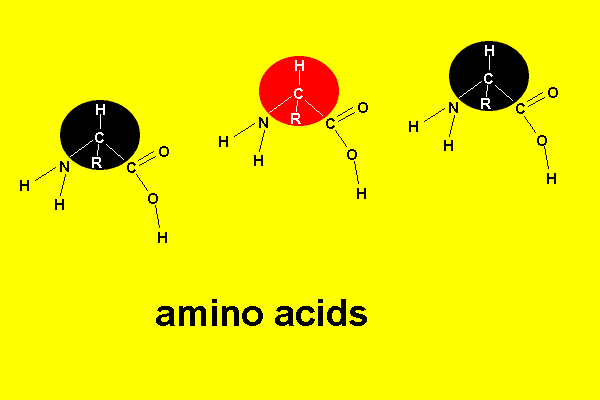
The -CONH- group of atoms, highlighted in the animation above, that link the amino acids together are called an amide bond.
Proteins differ from one another in the number of amino acids the type and order in which they appear along the protein chain. The sequence of amino acids determines the shape of the protein and therefore its function.
Each protein is said to be composed of three structures, primary, secondary and tertiary structures. A quaternary structure also exists and is composed of two or more tertiary structures.
The primary structure is the linear sequence of amino acids along the protein chain.
The secondary structure comes about due to attraction from hydrogen bonding between CO and NH groups of the amide link found along the protein chain. This causes some sections of the protein to fold or coil. Click to see a simple animation of the folding of the primary structure and the formation of helices and beta pleats.
Click to see an animation
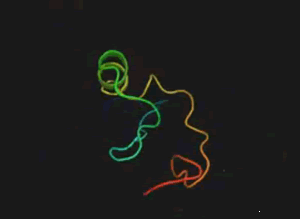
The tertiary structure comes
about when the amino acid side groups attract each other and cause the
protein chain to fold back on itself, forming an intricate and unique
shape. Ionic bonding is a common cause of such folding and comes about due to the
attraction of an NH3+ with an COO- group.
Covalent bonding can also occur between different parts of the protein
chain. For example, cysteine has an -SH side group. If two cysteine amino
acids come close then a disulfide(-S-S-) link forms. Click to see an animation of this linkage.
As the protein folds, a unique shape is achieved, dependent totally
on the primary structure. This unique shape allows enzymes to act specifically on certain reactions to increase their rate.
Click to read more about enzymes from a biological perspective
Click to see a summary of the bonds in the tertiary structure.
Click to see a summary of the protein structures. Source http://academic.brooklyn.cuny.edu
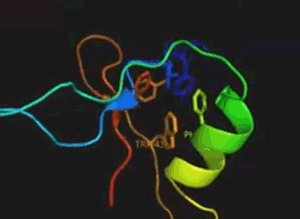
Two amino acids, cysteine
and serine, are shown on the right.
These two amino acids can combine together to form a dipeptide.
A dipeptide results from the condensation reaction two amino acids and
contains one peptide link.
How many different dipeptides can be formed?
How many peptide links are present in a tripeptide?
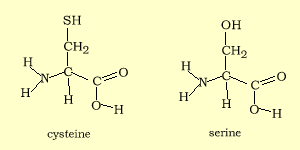
Draw the structural formulae of the dipeptides formed.
Solution
The two possible structures of the dipeptide are shown on the right. Click to see an animation of the condensation reaction. |
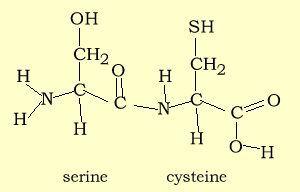 |
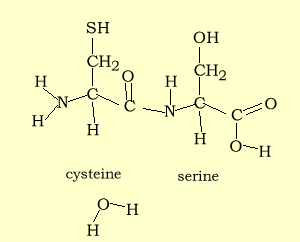 |
The structural formulae of
lactic acid and alanine are pictured on the right.
Which one of the two molecules is classified as an amino acid? Why?
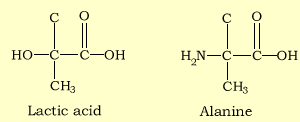
Solution
Hide the solution
| Condensation reaction to form a peptide. | 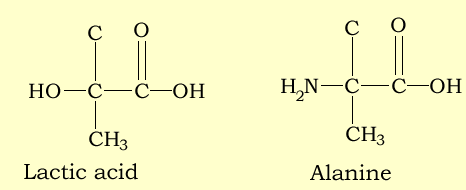 |
| Condensation reaction to form an ester. | 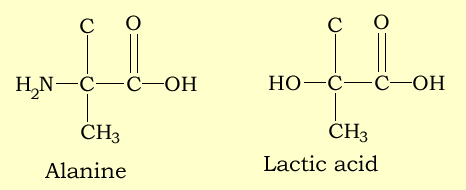 |
Consider the dipeptide shown on the right. Give the structural formulae of the two compounds that formed the dipeptide.
You may wish to review hydrolysis.
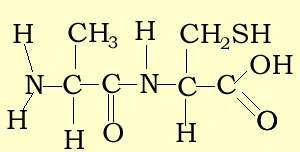
Give the semi-structural formulae of the compounds in a solution of :
Solution |
Compound
"A" |
Compound
"B" |
| pH = 3 | ||
| pH = 10 | ||
| isoelectric point |
Hide solution
Solution |
Compound
"A" |
Compound
"B" |
| pH = 3 |  |
 |
| pH = 10 |  |
|
| pH = 7 |  |
 |
Solution
A mutation occurs when an amino acid is wrongly placed in the primary structure of a protein, such as an enzyme. A single mutation can sometimes render the enzyme useless or it may have no effect at all. Explain why.
Click to see how the primary protein structure is determined